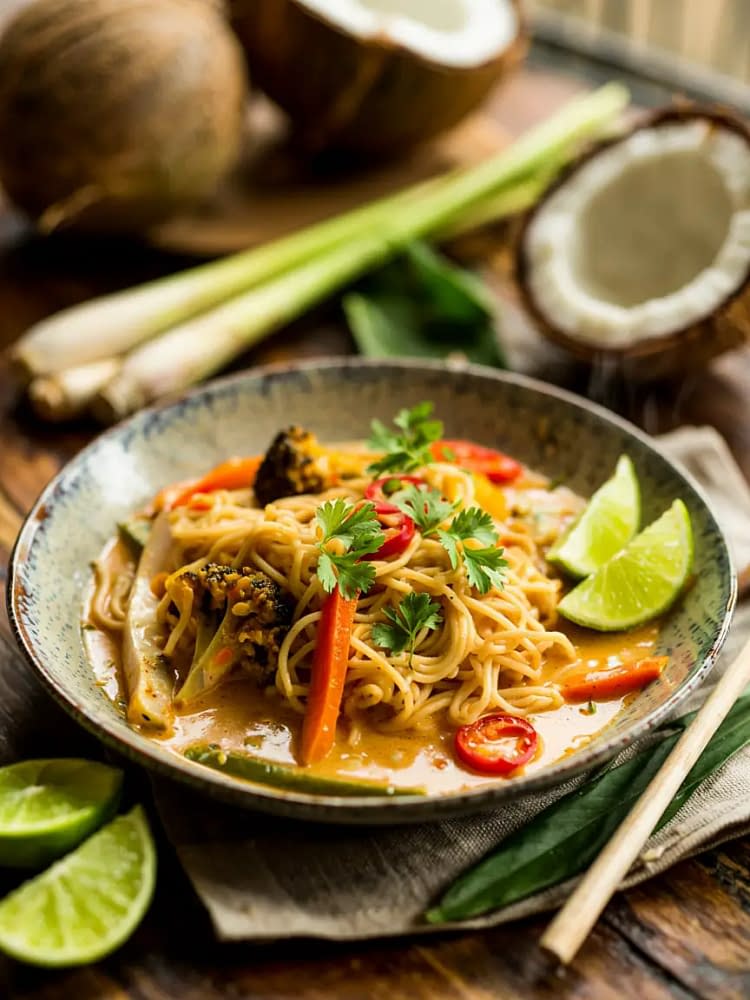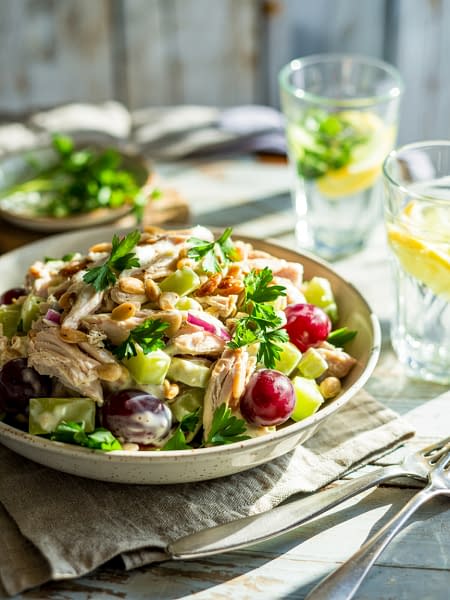If there’s one dish that perfectly balances comfort and exotic flavor, it’s Thai Coconut Curry Noodles with Lemongrass. Creamy, fragrant, and bursting with color, this noodle dish captures everything people love about Thai cuisine — the warmth of coconut milk, the zing of lemongrass, and the perfect harmony of spice and sweetness.
What makes it truly special is how easily you can bring authentic Thai flavors to your own kitchen with simple ingredients and step-by-step guidance. Whether you’re a seasoned cook or just starting out, this dish feels restaurant-quality yet approachable enough for a cozy weeknight dinner.
These Thai Coconut Curry Noodles are completely and can be made vegan or vegetarian without losing their rich, satisfying taste. The creamy curry sauce clings beautifully to tender rice noodles, while crisp vegetables and golden tofu add texture and freshness in every bite.
Why You’ll Love This Recipe
There are plenty of reasons this dish deserves a permanent spot in your dinner rotation. Here’s why home cooks everywhere fall in love with Thai Coconut Curry Noodles with Lemongrass:
- Incredible Flavor Balance: The combination of creamy coconut milk, tangy lime juice, and fragrant lemongrass creates the perfect mix of richness and freshness.
- Vibrant & Colorful: Bell peppers, broccoli, carrots, and snow peas add visual appeal and a range of textures.
- Vegan-Friendly: Made entirely from plant-based ingredients and easily customizable for your preferences.
- Quick & Satisfying: It takes under 40 minutes from start to finish — perfect for busy evenings when you still want a homemade, nourishing meal.
- Customizable: Works beautifully with tofu, shrimp, or chicken — depending on your mood or dietary needs.
This recipe is a fantastic way to enjoy Thai flavors at home without needing special equipment or rare ingredients.
Recipe Overview
- Preparation Time: 15 minutes
- Cooking Time: 25 minutes
- Servings: 4
- Difficulty Level: Intermediate
- Cooking Temperature: 180°C for simmering
- Best Season: All seasons — warm enough for winter, light enough for summer
Ingredients You’ll Need
Let’s take a closer look at everything that goes into this comforting bowl of Thai goodness.
For the Curry Base:
- 1 tbsp vegetable oil
- 1 tbsp sesame oil (optional for aroma)
- 3 cloves garlic (minced)
- 1 tbsp fresh ginger (grated)
- 2 stalks lemongrass (outer leaves removed, inner stalk minced)
- 2 tbsp Thai red curry paste
- 1 can (400 ml) coconut milk (full-fat for creaminess)
- 1 cup vegetable broth
- 1 tbsp soy sauce (or tamari for gluten-free option)
- 1 tbsp brown sugar or coconut sugar
- 1 tbsp lime juice (freshly squeezed)
For the Noodles & Vegetables:
- 250 g rice noodles
- 1 cup bell peppers (sliced, any color)
- 1 cup carrots (julienned)
- 1 cup broccoli florets
- ½ cup baby corn (sliced)
- ½ cup snow peas (trimmed)
- 1 cup tofu (cubed and pan-fried)
For Garnish:
- Chopped cilantro
- Sliced red chili (optional)
- Lime wedges
- Toasted sesame seeds or crushed peanuts
Step-by-Step Cooking Instructions
Cooking Thai Coconut Curry Noodles with Lemongrass is all about layering flavors. Each step builds on the last to create a deep, aromatic sauce that clings perfectly to your noodles. Follow these steps carefully for the best results.
Step 1: Prepare the Noodles
Start by soaking or cooking your rice noodles according to the package instructions. You want them just tender — not mushy.
Once they’re ready, drain and rinse under cold water to stop the cooking process. Set aside in a colander.
Pro Tip: Toss the noodles lightly in sesame oil to prevent them from sticking while you prepare the sauce.
Step 2: Sauté the Aromatics
In a large skillet or wok, heat the vegetable and sesame oil over medium heat. Add the minced garlic, grated ginger, and finely chopped lemongrass. Sauté for 2–3 minutes until fragrant and golden.
This is your aromatic base — it releases the essential oils that make the curry deeply flavorful.
Step 3: Stir in the Curry Paste
Add the Thai red curry paste to the aromatics. Stir well and let it cook for about 1 minute. This step helps the curry paste “bloom,” intensifying its aroma and blending it with the lemongrass and ginger.
Step 4: Build the Creamy Sauce
Slowly pour in the coconut milk while stirring to combine. Then add the vegetable broth, soy sauce, and brown sugar. Stir everything together and let it simmer gently at 180°C for about 7–10 minutes.
The sauce should start to thicken slightly and take on a silky, rich texture.
Chef’s Tip: Don’t boil too vigorously — gentle simmering helps preserve the creamy consistency of the coconut milk.
Step 5: Add the Vegetables
Now, add the vegetables in stages, starting with the firmer ones like carrots and broccoli, followed by bell peppers, baby corn, and snow peas. Let them cook for 5–7 minutes until tender but still crisp.
This keeps your vegetables vibrant and prevents them from becoming soggy. The goal is freshness and a bit of crunch!
Step 6: Combine with Noodles and Tofu
Add the cooked rice noodles and tofu cubes into the curry sauce. Use tongs to gently toss everything together until the noodles are well-coated and the tofu is heated through.
Simmer for 2–3 minutes so the noodles absorb some of the flavorful curry sauce.
Step 7: Add the Final Touches
Turn off the heat and stir in the lime juice for a bright, zesty finish. Adjust seasoning with a touch of soy sauce or salt if needed.
Serve hot, topped with chopped cilantro, sliced red chili, toasted sesame seeds, and lime wedges.
Serving Suggestions
These noodles are delicious on their own but can easily become a complete meal with a few additions:
- With Protein: Add pan-seared shrimp, shredded chicken, or chickpeas for extra protein.
- With Rice: Serve the curry sauce over steamed jasmine rice for a hearty meal.
- With Garnishes: Crushed peanuts, a drizzle of chili oil, or extra herbs can elevate presentation and taste.
Pair your Thai Coconut Curry Noodles with Lemongrass with a refreshing cucumber salad or Thai iced tea for a full restaurant-style experience at home.
Expert Tips for Perfect Thai Coconut Curry Noodles
- Use Fresh Lemongrass: It’s the star of this dish. If unavailable, use lemongrass paste — but fresh always tastes brighter.
- Coconut Milk Matters: Choose full-fat coconut milk for a creamy, luxurious texture. Light versions can make the sauce too thin.
- Balance the Flavors: Thai cuisine thrives on balance — if it’s too spicy, add more coconut milk or sugar. Too mild? Add a little more curry paste.
- Don’t Overcook Noodles: They’ll continue to soften in the sauce, so slightly undercooked noodles are ideal before tossing them in.
- Simmer Gently: Boiling the coconut milk too hard can cause it to curdle or separate. Keep it to a gentle simmer for a smooth sauce.
Variations to Try
- Vegan Thai Coconut Curry Noodles: Stick to tofu and skip any fish sauce (use soy sauce instead).
- Thai Green Curry Noodles: Swap red curry paste for green curry paste for a herbier flavor.
- Peanut Curry Noodles: Add 1 tbsp of peanut butter for a rich, nutty twist.
- Spicy Lemongrass Chicken Noodles: Replace tofu with thinly sliced chicken breast marinated in soy sauce and ginger before cooking.
- Low-Carb Option: Use spiralized zucchini or rice noodles made from konjac for a lighter version.
Storage and Reheating Instructions
- Refrigeration: Store leftovers in an airtight container for up to 3 days.
- Reheating: Warm gently on the stovetop with a splash of coconut milk or broth to loosen the sauce.
- Freezing: Not recommended — coconut milk may separate when thawed, affecting texture.
Perfect Occasions to Serve It
Thai Coconut Curry Noodles with Lemongrass fits beautifully into any occasion:
- A cozy family dinner
- A flavorful meal prep for work lunches
- Weekend comfort food when you crave something creamy yet light
- A crowd-pleasing dish for parties and gatherings
Its versatility makes it suitable for any season — rich enough for winter comfort yet refreshing enough for warm-weather dining.
Final Thoughts
Thai Coconut Curry Noodles with Lemongrass is one of those recipes that checks every box — comforting, nourishing, colorful, and irresistibly flavorful. It celebrates the essence of Thai cooking: a beautiful balance of sweet, sour, spicy, and creamy elements that come together in perfect harmony.
Whether you’re cooking for your family, meal prepping for the week, or just treating yourself to something special, this dish promises to impress every time.
Once you try it, it’ll become one of those recipes you return to again and again — because few things compare to a warm bowl of noodles coated in fragrant, coconut-infused curry with the refreshing brightness of lemongrass.
Thai Coconut Curry Noodles with Lemongrass Recipe
Warm, creamy, and bursting with Thai-inspired flavors, these Thai Coconut Curry Noodles with Lemongrass blend the richness of coconut milk with the citrusy fragrance of lemongrass and zesty curry paste. Tender rice noodles are coated in a silky curry sauce and mixed with vibrant vegetables, creating a comforting, satisfying meal perfect for any day of the week. This easy stovetop noodle recipe is dairy-free, halal-friendly, and packed with flavor in every bite.
Ingredients
For the Curry Base
For the Noodles & Vegetables
For Garnish
Instructions
Prepare the Noodles
- Soak or cook rice noodles according to package instructions until just tender (al dente). Drain and rinse under cold water to stop the cooking process. Set aside.
Infuse the Aromatics
- Heat vegetable oil and sesame oil in a large skillet or wok over medium heat. Add minced garlic, ginger, and lemongrass. Sauté for about 2–3 minutes until fragrant and lightly golden — this forms the aromatic base of your curry.
Build the Curry Sauce
- Stir in Thai red curry paste and cook for 1 minute, allowing it to blend with the aromatics. Slowly pour in coconut milk and vegetable broth, stirring well. Add soy sauce and brown sugar. Let the sauce simmer gently for about 5–7 minutes at 180°C until it slightly thickens.
Add the Vegetables
- Add bell peppers, carrots, broccoli, baby corn, and snow peas to the simmering sauce. Stir to coat evenly and cook for another 5–7 minutes until vegetables are tender but still crisp.
Add the Noodles and Tofu
- Toss the cooked noodles and golden tofu into the pan. Mix well so the noodles are fully coated in the curry sauce. Let everything simmer together for 2–3 minutes to absorb flavors.
Finish with Freshness
- Turn off the heat and squeeze fresh lime juice over the noodles. Adjust seasoning with extra soy sauce or a pinch of salt if needed.
Serve & Garnish
- Transfer to bowls, top with chopped cilantro, sliced red chili, and toasted sesame seeds or peanuts. Serve hot with lime wedges on the side.
Note
Storage: Store leftovers in an airtight container in the refrigerator for up to 3 days. Reheat gently with a splash of coconut milk or broth.
Protein Alternatives: Substitute tofu with cooked shrimp, chicken breast, or chickpeas (all halal).
Spice Level: Adjust curry paste to taste — add more for a stronger, spicier kick or use a mild Thai curry for a subtle flavor.
Noodle Options: You can also use soba, udon, or egg noodles (halal-certified) for variation.
Make it Vegan: The recipe is naturally vegan-friendly. Just ensure the curry paste doesn’t contain shrimp paste.







